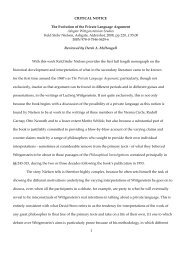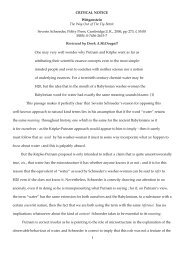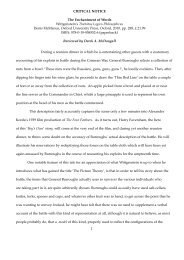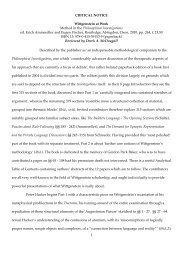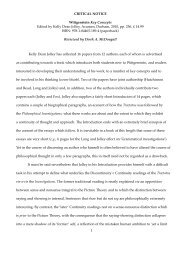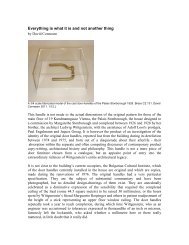Wittgenstein's Philosophical Investigations A Critical Guide
Wittgenstein's Philosophical Investigations A Critical Guide
Wittgenstein's Philosophical Investigations A Critical Guide
Create successful ePaper yourself
Turn your PDF publications into a flip-book with our unique Google optimized e-Paper software.
of ‘other minds’ that merely accompanies our practice, yet which he is almost irresistably inclined<br />
to see as encapsulating the meaning of these statements about others’ private experiences.<br />
This message is conveyed in that sequence of passages centred on § 426, where the straight<br />
highway leads right up to the picture - in this case of ‘other minds’ - that it seems he cannot apply<br />
in the way that the philosopher is inclined to think that he must be able to apply it if he is to be<br />
a realist about other minds. Just as realism accepts that the picture properly conveys what these<br />
statements actually mean, anti-realism complains that we cannot really have any proper conception<br />
of where the highway appears to be taking us, because we have no way in principle of finding out<br />
whether what is portrayed in the picture is really so. Wittgenstein’s principal point, however, is that<br />
if the highway is leading nowhere, it is rather because the determination to adopt either a realist or an<br />
anti-realist outlook, depends on granting to the picture a role in one’s thinking that is doing no real<br />
work, because the real work is being performed through active participation in the practice itself.<br />
Arif Ahmed contributes an Introduction of ten pages, in which he claims that the<br />
<strong>Philosophical</strong> <strong>Investigations</strong> is probably the most disturbing work of philosophy since Hume’s Treatise,<br />
disturbing because it shatters certain images of mankind that have been important within the Western<br />
Tradition. He follows a brief survey of the relationship between the Tractatus and the <strong>Investigations</strong><br />
by listing 15 topics that the <strong>Investigations</strong> is said to discuss, 10 of which are covered by his chosen<br />
authors. The remainder of the Introduction is occupied with brief synopses of the papers which<br />
follow. Whilst the overall direction of the volume is towards the theoretical rather than towards the<br />
therapeutic, with possible exceptions in the cases of McDowell, Stern and Horwich, the end result, as<br />
is usual with volumes of this kind, is something of a mixed bag, so much so that it would not be<br />
entirely true to say that every paper critically engages with the text of the <strong>Investigations</strong>, as the book’s<br />
inclusion in the Cambridge series would suggest. This would clearly be less true, for example, of the<br />
three more therapeutically inclined examples already mentioned. Arif Ahmed has nevertheless done<br />
a pretty good job of ensuring that the volume does make a useful contribution to our understanding<br />
of Wittgenstein.<br />
32



